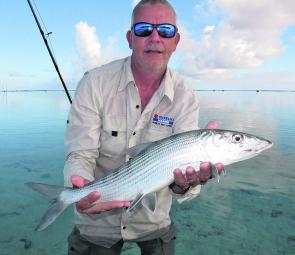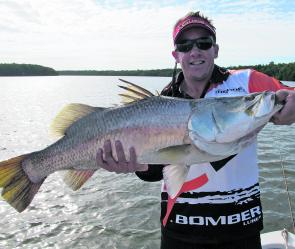How many times have you been told, “Be quiet, the fish will hear you.” Or, “Don’t drop that in the boat.” Like me, probably quite a few times. In this article, I will try to give a few accounts of my experiences and ideas on the subject of noise on the water while fishing.
Certainly noise and vibration have a major role in fishes’ everyday lives. Predators can feel vibrations of prey and prey obviously feel predators coming their way. Sharks are a classic example of this, as they can home in on a struggling fish from a great distance, and quite quickly I must add.
Right next to me here in the living room, I have a pet 30cm mangrove jack in a 2m tank. He’s the third jack I’ve kept as a pet; the largest grew to 54cm and was pretty impressive. Along with barras, Australian bass and a few peacock bass, jacks are by far the most alert fish you can keep.
They soon learn when it’s feeding time. Seeing me approach the tank with a handful of prawns or herring, he gets pretty active. I have, on a few occasions, crept up to the tank and dropped a couple of live herring in while he was swimming on the other side of the main snag, but as soon as the baitfish began to rattle down in the water column, he was onto it, even though he couldn’t see them. I think there’s a lesson here; he could actually hear or feel them moving erratically
The recent popularity in soft vibe lures is most certainly in the ‘vibe’ action. As you lift the lure, this certainly attracts fish, as they seem to home in on this and bite ‘on the drop’ as the lure sinks back down. Obviously these lures have no noise; the fish sense them and they work well in dirty and deep water. Just like those live herrings in my tank!
We spend a lot of time fishing in the Mary River and the Great Sandy Straits for big threadfin salmon. Finding them in shallow gutters and drains, they can be seen actively hunting bait and are easy to approach, sometimes as close as 5m. I originally fished from a little 4.1 Polycraft, 4-stroke outboard and electric motor up front, as it was a super quiet vessel, but after upgrading to a small plate alloy boat, I was frustrated as I couldn’t get within 50m of these fish. You could actually see them slink off into deeper water as we approached!
It didn’t take long for the penny to drop; they could hear the tiny wave slap against the hull. I took a mate’s Poly out and we were on them again. I’m not knocking alloy boats, but in this circumstance it was a case of quieter the better. Possibly my father’s lectures years before had some truth in them after all?
HydroWave is the latest electronic gadgetry designed to imitate the underwater sounds baitfish and predators make. I fitted one to my last boat and they attracted bull sharks right up close, so it can certainly be heard, I guess, but I never spent enough time with it and sold the boat not long after. Now I have a big Fusion stereo mounted in my centre console, I plug in the iPod and really crank up some tunes, and anything with a hard beat to it seems to get fish active. On a dead still winter’s day, having the stereo cranking seems to bring snapper to the boat, but is this a coincidence or can they hear the vibrations? I have caught too many fish using this tactic to write it off as a ‘maybe’. It works, especially with the barras in the river, but snapper and tuna offshore as well.
Pelagics such as tuna, queenfish, mackerel and trevally are other species that can be attracted to sound, as long as it’s the right one. How many times have you approached a school of feeding tuna, only to have them disappear just out of casting range — frustrating isn’t it? Try approaching from upwind of the school and not only does it improve your casting distance with the wind at your back, but a boat idling in with the waves is much quieter than one punching into them. Just come in slow; there’s no need to roar straight in at 100km/h like some anglers do, as this only puts the school down.
Remember the second paragraph where I wrote predators could feel prey and prey can feel predators coming? Just think what the push of a boat hull would feel like to a tuna — possibly the world’s biggest shark! No wonder an aggressive approach spooks them.
Electric motors are a great invention, brilliant for positioning a boat, Spot Lock in the current and so on, but how quiet are they? I wouldn’t have a boat without one, but they are noisy underwater. When guiding clients in shallow water on golden trevally with fly tackle where you must get close for a cast, we could actually see the fish holding at a distance from the boat. The harder you pushed the electric, the faster the fish would swim away. They can certainly hear it, so I’d stop the electric and the fishes’ body language would change and they would happily start tailing on the yabby bank again
Another classic example occurred recently. I was sitting on a school of 20 odd barras, anchored on the side of the hole, while a mate I called in was sitting out in the current with his electric motor holding him bow first into the tide. We were all casting deep divers and plastics over the fish, but watching them on the sounder they were hugging the bottom and very inactive. My mate dropped off with frustration and worked his way downstream, but almost instantly the fish rose off the bottom and we got bites.
Interestingly, as soon as the electric returned (after seeing us land fish!) the barras went back into stealth mode and hugged the bottom, refusing to bite. I’ve heard some old game boat skippers talk about ‘fishy’ boats that catch more than others, possibly due to different engine/propeller noise or vibrations. Most anglers trolling for billfish work a spread of lures and/or teasers to create as much noise and splash as possible to attract fish from afar.
On the flip side of all this, certain species like mulloway and bream — species that can be easily spooked — certainly don’t need excess noise to create interest. Dead calm water is a very tough time to approach them. We used to catch a few nice mulloway off a local boat ramp at night, but if a boat launched or returned, the fish would disappear for a good hour before they showed again.
Even when walking the bank, fish can feel hard footsteps. The humble freshwater mullet is a classic example. As a kid we used to stalk them along my grandfather’s property’s creek. Sneaking in close to the big mullet as they grazed on algae, we would stomp our feet and the fish would tear off like scalded cats. They could feel the vibration no worries at all. So there you go, my thoughts on fishing and noise. So go play a few heavy songs and see if your catches improve!
BargNoise0315_1
This is definitely no place for noise — dead calm water and spooky fish like this nice bonefish caught by Murray Smith.
BargNoise0315_2
Saratoga can hear a loud surface fly from quite a distance away.
BargNoise0315_3
Electric motors allow for a stealthy approach, but how quiet are they really?
BargNoise0315_4
Billy from JM Gillies with a nice salty barra caught on a big Classic Barra lure in the Pine River. Did the inbuilt rattle help get the bite?
BargNoise0315_5
This snapper was caught in the middle of the day, after the stereo was cranked up to full noise. Was it the vibration that produced the bite?
Reads: 1468








